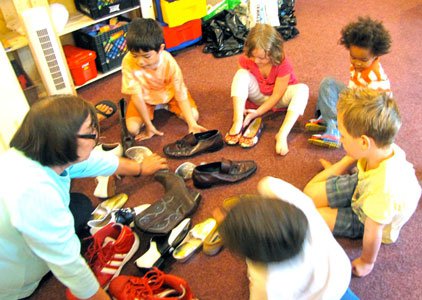October is national anti-bullying month in the U.S. How can emotional intelligence help us guide our children to be compassionate and to combat bullying at home and at school?
As a first grader, I was a bit chubby—not pudgy, but certainly slightly rounded. My father always referred to me as healthy looking. However, the first graders twisted my name—Anabel—around and called me Belly Anne. I confess that I did not like it.
Was it mean? Yes.

Was it necessary? No.
Was it important? No.
Was this bullying? No, I do not think so.
I think it is important to recognize that an accurate definition of bullying implies two essential ingredients: one of them is a real or perceived imbalance of power; the second one is a repetition of the event. Certainly, the incident happened more than once. However, we were all first graders; no one had any more power than any other did. If, on the other hand, a fifth grader had taken to using the name, then I would identify this as bullying from her. She was bigger and older. The power imbalance can be social or emotional, someone who is louder, meaner, or who can marshal other kids to join them.
In reviewing the recent literature on bullying, I was fascinated to see in Julie Lythicott-Haims new book, How to Raise an Adult: Break Free of the Overparenting Trap and Prepare Your Kid for Success, that she mentions that bullying statistics have not gone up—but have stayed about the same. She suggests that was has gone up are parents’ sensitivity to perceived inappropriate behaviors, which they interpret as bullying.
What is Bullying? And What Isn’t?
Not all confrontational behavior can or should be defined as bullying, though. Kids are active and impulsive, and they are going to have spontaneous scuffles, friendship spats, and wrestling matches that occasionally get out of hand. Everyday play-related conflict can make kids stronger because they learn through experience how to compromise, negotiate, and forgive. Sometimes it appears that this element is disappearing.

Interestingly, the research literature does report an increase in bullying in the transition period before high school. I wonder if there is also an increase in the transition period from preschools to the more restrictive atmospheres of many current kindergartens? I would love to see some research here.
While bullying has no one particular group of targets, statistics and research highlight certain groups that are more prone to being bullied than others. Those are:
1- People with weight problems
2- People with disabilities
3- People who belong to racial or religious minorities
4- People who are LGBTQ or perceived as LGBTQ.
Don’t be a Passive Bystander
This then is a skill that most be taught at all grade levels. Children need the skills to step in, get a teacher, pull in another friend (and outnumber the bully) in order to prevent whacks and smacks. For little children, this can be demonstrated visually in a variety of scenarios so they understand how they might help. Essentially, they are first-responders. I want children to understand the value and the importance of being a first-responder.
Replace Bullying with Kindness
In addition, of course, anti-bullying programs should not exist for just one week or one month; instead, there must be consistent and on-going reminders of the importance of kindness.
In fact, some data suggests that a kindness campaign might have more effect than zero-tolerance policies rules, reducing bullying at some schools by as much as 40%. Taking the positive approach (please do this) appears to be more efficacious than the negative (don’t do this).
Therefore, to begin—teachers must be vigilant. If the school does not have a positive kindness campaign in the offing, start one in your classroom. It will spread.
Keep an eye always on the subtle behaviors you may miss—in the hallways, out at recess, during lunch break and then use the witnessed moment as an opportunity to teach and praise the appropriate behavior.
And, the solution should focus on both the perpetrator and the victim. For example, the instigator should learn strategies to control their anger and not blame others for their problems. Victims, on the other hand, need interventions that speak to self-efficacy and not to blame themselves. And, by-standers need to learn that witnessing an event is not a neutral response and that they need to oppose bullying behaviors actively.
It would appear that taking a page from the research of Durlack and Weissberg is appropriate here. Schools can begin a formalized social and emotional learning (SEL) program—one that teaches a new lesson every week, and that is also woven into the curriculum of the students.
Click here for some SEL resources from Six Seconds to help you get started.
Be aware that teachers, administrators, parents, and staff need workshops and seminars to learn the skills to deflect bullying actions. The research on these program show consistent decrease in anti-social actions, as well as increased achievement. Built into these programs should be an emphasis on developing an appreciation for the diversity in our world—to be less judgmental of those who are different. For me, these differences create beauty.
Key Tips to Use Emotional Intelligence to Reduce Bullying
In summary, here are some specifics to practice—for all who care for children:
- Before transitions, remind students to be kind. A few reminders about how important empathy is to building friendships and may squelch the insensitive antics.
- Discuss with students what the consequences will be for bullying behaviors. Remind them the biggest consequence will be no friends—no one asking to come to your house for a play-date.
- Teach students that saying sorry is not a consequence. Instead, have the student right the wrong. Without fail, have the instigator have to perform a prescribed number of kind acts and make sure to follow up on the execution of the acts.
- Praise all efforts seen in the classroom and on the playground. Be specific: “I like the way you invited someone new to play. I like that you took turns with the jump rope.”
My wish for the future coincides with the words of Lao Tzu, “Kindness in words creates confidence. Kindness in thinking creates profoundness. Kindness in giving creates love.”
- 87 Ways to Be Kind and Loving - June 27, 2022
- 13 Tips to Reduce Stress & Anxiety During Covid-19 - April 8, 2021
- 6 Tips for Making the Best of Your Reality - October 12, 2020


Hi I am from the philippines I attended parent’s meeting today I confronted my 11 years old teacher because my daughter is repetitively being bullied at school and threatend by his 2 boys classmates to be thrown in a bridge on her way home. I was very worried for my girl,She also told me that she was always told different shaming names like pig and others and even mentally abnormal.I know my child is very kind but sensitive but she is loving,she is my only daughter.I though the teacher will acknowledge my sentiments as a mom however she told me my daughter always start the fight at school.According to my child if she tries to complaint some of her sitmates are blocking her way so that she will not have the opportunity to told her teacher what is happening and it happens everyday.I talk to the school head and she told me my child should undergo IEQ test.I feel pitty to my child for it seems like she don’t have someone to understand her at school.I don’t know what to do please help
Thank you for writing this article. I wish that instead of Anti-Bullying Month, we could all collaborate into a Year of Kindness. By making Resources Available for Parents, Teachers or anyone that works with children, we could make a powerful change. I believe that children already have all the gifts that they need for success. As parents, counselors, teachers, or mentors we have the opportunity to help them unwrap their talents and help them develop into the people they were meant to be.
I am a firm believer that it begins with us. They look to us as role models and also for guidance. The better we can be at knowing what we feel, choosing how we act, and giving of ourselves, the braver our children will be to follow in our footsteps.
One of the things that I tell my children is We will not be those who hurt on purpose, victims, or bystanders. It comes from one of my favorite quotes :
“Thou shall not be a perpetrator, thou shall not be a victim, but, above all, thou shalt not be a bystander.” Yehuda Bauer
They seem like very simple words to live by but they are harder to live by on a day to day basis.
HI Analia – I so agree with you, and I know Anabel does too – the solution to ending bullying is adding peace, compassion, and kindness. Check out this video: https://www.youtube.com/watch?v=-Jer4mG0MkQ
I’m thrilled to see someone mention “a Year of Kindness”! My guided journal of the same name, although not created specifically as an antidote to bullying, is something I would love to see incorporated into schools’ SEL or anti-bullying programs, and I would love to see data on its effects. Any school that is interested in using the journal for this purpose can get it at my cost by contacting me through http://www.ayearofkindness.com